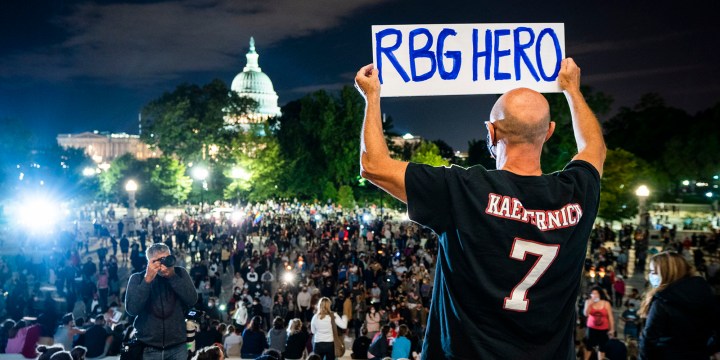CROSSROADS
Ruth Bader Ginsburg’s death poses a supreme political question for the US

As with South Africa in its mourning for the death of George Bizos, the US has now also lost a legal giant in the person of Ruth Bader Ginsburg. One crucial difference is that while both were renowned for their fearless advocacy on behalf of those discriminated against in law, Ginsburg eventually joined her nation’s apex court. Her death, within weeks of the 2020 election, is triggering a fierce fight over how her successor will be named.
Ruth Bader Ginsburg, Associate Justice of the US Supreme Court, died at age 87 on the first evening of Rosh Hashanah, the Jewish New Year, after a career in which she had become an agenda-setting legal activist for civil and women’s rights, the principled core of the liberal-progressive wing of the Supreme Court, and an unlikely cultural icon for many who may have barely known what a Supreme Court justice actually did with their days.
RBG, or as she was frequently referred to in her later years, the “Notorious RBG” in a clever echo of the moniker of pop star Notorious BIG, had studied at top law schools and then lawyered at a time when those were still unusual professional and educational choices for women. Finishing first in her law school class, she was still unable to gain a prestigious clerkship with a federal judge, the usual ticket for the successful rise to the upper tiers of the profession for the very best students from the very best law schools.
Regardless, she pushed on to work with Swedish legal scholar-activists on comparative gender equality law, became a law professor at various US universities, and a founding star of the American Civil Liberties Union’s gender equality law unit – that at a time when this field barely existed in the US. Along the way, as a careful student of legal psychology, she often selected male plaintiffs to make the case – successfully – for overturning laws that differentially treated people according to their gender.
Appointed to the Supreme Court by President Bill Clinton, her biggest judicial moment on the Supreme Court came when she wrote the majority decision in the case of United States v Virginia Military Institute which threw overboard the male-only student admissions policy of the state-funded VMI, a university with an august tradition of educating male-only military officers. In her decision, RBG wrote that because VMI had failed to show “exceedingly persuasive justification” for its sex-based admissions policy, it violated the Fourteenth Amendment’s Equal Protection Clause. (That clause had previously only been seen as relevant with respect to race.)
In an attempt to satisfy equal protection requirements, the state of Virginia had proposed a parallel programme for women, called the Virginia Women’s Institute for Leadership (VWIL) at Mary Baldwin College, a private liberal arts women’s college. But, her opinion said, “The VWIL programme is a pale shadow of VMI in terms of the range of curricular choices and faculty stature, funding, prestige, alumni support and influence,” thereby overturning generations of practice. In many ways, this decision can be seen as the gender equality equivalent of what Brown v The Board of Education had achieved two generations previously for legislated racial segregation during the activist years of the Warren Court.
Sadly for her, however, RBG had joined a court that increasingly had a conservative complexion. Even though she became the voice and centre of the liberal, progressive side of the court, many of her opinions would be dissents, rather than majority opinions. In a sense, she was doomed to wait unsuccessfully for a return to the political centre for the court with new appointments by a future president, let alone to earlier, still more liberal, activist positions. In this hope, she stayed on at her post, through multiple bouts with cancer, broken bones, pneumonia and other ailments, until pancreatic cancer was her final hurdle.
Along the way, by virtue of her life, her work, and her opinions, RBG became an icon to succeeding generations of women (and millions of men, too) for her unflinching activism for gender equality. But it was her human qualities that endeared her to many people as well. Late in life, for example, her exercise routines in online videos became a sensation for many, and her outspokenness on issues made her a star as well.
But most surprisingly, perhaps, in our over-stressed political era, was RBG’s ability to demonstrate that one could still maintain civil, even warm, friendly, relations with people one disagreed with profoundly, even when they vigorously crossed swords over their views. She famously enjoyed attending opera performances with her ideological opposite on the court, the late Antonin Scalia, the hard-edged “originalist” thinker who was in stark opposition to her own “living constitution” position that argued interpretations of that founding document must move with the times and real lives of people.
Their mutual love of opera even led to the two of them sometimes being cast as (non-singing) supernumeraries in professional opera productions. And their legal debates even formed the core of a contemporary opera, Scalia/Ginsburg, by Derrick Wang.
But, even before the commemorations of her life, the funeral arrangements, and the encomiums on her career had been completed, a fierce battle is already raging over the appointment of her successor. The US Constitution says the president has the power to nominate individuals for the federal courts, including the Supreme Court, but it is the responsibility of the Senate to consider these nominations, to have hearings on nominations and then to vote yes or no on such nominations. In the case of a Supreme Court nomination, the hearings in the Senate’s Judiciary Committee become high drama, even before the final vote occurs in the Senate.
But, here’s the rub. The presidential election is only a month and a half away, and there is now a distinct possibility President Trump will become former president Trump by the time all the ballots are counted. Back when Barack Obama was in the final year of his presidency, he announced his decision to nominate federal judge Merrick Garland to the newly vacant seat Antonin Scalia had occupied on the Supreme Court until his sudden death. Republican Senator Mitch McConnell, the Senate Majority Leader, then announced there would be no movement on this nomination because it was less than a year before an election. Sorry Obama, no dice.
Post-2016, and Donald Trump’s election, the new president nominated Neil Gorsuch for this vacant seat and the Republican-controlled Senate moved expeditiously to have Gorsuch’s confirmation hearing and final vote, and he was duly confirmed. What a difference four years make….
Now McConnell insists such a precedent couldn’t possibly apply to this current vacancy because, unlike in 2016, both the Senate and the presidency are held by the same party. And a raft of Republican bigwigs who previously proclaimed the gospel of McConnell in 2016 have backed away from any such conditionalities for the new vacancy.
While the Republicans will certainly try to schedule hearings and a vote on Trump’s nominee, getting confirmation may be a bit more complicated than it seems at first blush. First of all, two Republican senators, Lisa Murkowski and Susan Collins, are telegraphing their disagreement with forcing a vote on a nominee just weeks before an election. If they hold to that opposition, if Democrats all remain solidly opposed, and if this opposition can recruit two more senators to that stance, the final confirmation would be stopped in its tracks. If. Otherwise, on a straight party vote, the current Republican/Democratic 53-47 split in the Senate with Republicans on top would probably carry the day.
But hold on a minute. Let’s also remember that the Republican senator from Utah, Mitt Romney, had previously voted to convict the president on one of the articles of impeachment – so maybe he is not a solid, automatic yes vote for the president on this one too. And there is one more wrinkle.
If the Democrats can possibly stall the vote until after the 3 November election, if the Republicans themselves decide to tap the brakes, or if some awkward information appears about the nominee, the nomination might actually only come up before committee after the election, when the Senate returns for a “lame-duck” session before the newly constituted Senate is sworn in for the new Congress. (Thirty-five senator seats are up for election this time around and the majority of those are Republican-held now. Democrats may well win some of them.)
But there is yet one more issue to note on the mechanics of voting for a new associate justice. When Republican Senator John McCain died, the Arizona governor-appointed Martha McSally to his position. As a result, this seat is now subject to a special election coinciding with the national general election. Because she was appointed rather than elected, if her Democratic opponent, former astronaut Mark Kelly wins, by the rules, McSally’s tenure would end the moment the vote was certified, presumably around 9 November, and Kelly would be sworn in in her place, thereby giving him the formal position and a little bit of seniority ahead of every other senatorial newbie.
That, in turn, would change the Republican/Democratic power balance to 52-48 for the lame-duck session that would come after the 3 November election but before the official swearing in of the new Senate, in early January. That, in turn, would mean Democrats would only have to get three more votes (Murkowski and Collins) to stop a Trump Supreme Court nomination until a new (presumably Democratic) president and a new (presumably more Democratic) Senate were all also in office. If all of this were to happen, the nomination to fill RBG’s big shoes would now be Joe Biden’s to make, rather than a newly ex-president Trump. At least, that is how Democratic strategists are gaming this one.
This matters a great deal, because the names Trump is reported to be considering for his nomination (two female, lower court federal judges) are substantially more conservative in their legal values than was RBG, and more similar to the views of the late Antonin Scalia. A successful nomination for Trump’s pick would then give the court a 6-3 conservative split, with several of those relatively young, conservative justices likely to serve for decades still.
Many observers note this means the remaining elements of Obamacare and even, perhaps, a woman’s right to choose/abortion rights could well come under threat. In fact, a review of a lower court ruling disallowing Obamacare as law is already set to be heard by the court soon, although a Supreme Court ruling on this would not come before the US spring. Yet other cases might well need to be heard on an emergency basis, however, arising from the election right on the horizon.
While the successor to the late Ruth Bader Ginsburg has become an unexpected issue for the presidential election, for Donald Trump and Joe Biden, both, this court vacancy is now a major part of this year’s astonishing presidential election, right along with the pandemic, the ongoing economic disaster, the racial tumult, and the environmental climate issue exemplified by the vast fires across the West. This court vacancy will energise the respective partisan bases, and, at least at this point, no one knows exactly how it will all play out. No one. DM




















 Become an Insider
Become an Insider
Comments - Please login in order to comment.